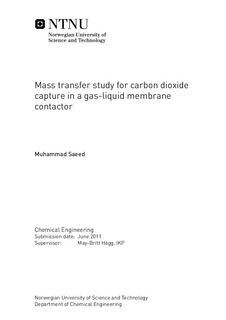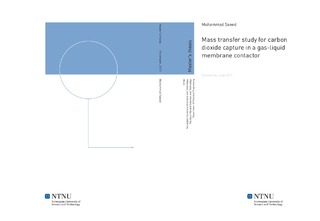| dc.description.abstract | Emission of green house gases especially CO2 has become a major environmental issue. In order to control and reduce the CO2 emissions, carbon capture and storage (CCS) is an important tool. Removal of acidic gases by absorption in alkanoamines (MEA, DEA, etc), alkali salt (Na2CO3, K2CO3, etc) and alkali solutions (NaOH, KOH. etc) by using packed/ tray absorber column is a well known process.
Membrane technology is a relatively new but promising candidate in this field. Since its introduction, several goals have been achieved but still a lot more is needed to make this technique compatible with existing technology. Gas-liquid membrane contactor is a hybrid process that offer advantages such as high specific surface area and selectivity. Numerous studies have been carried out for better understanding of mass transfer mechanism and to address the difficulties in operation for one of the most attractive and challenging application of membrane contactor: the absorption of CO2.
Membrane contactors based on micro-porous hydrophobic materials offer remarkable performance; flux of CO2 can be significantly enhanced by using highly permeable membrane. Nevertheless, undesirable effects, as gradual changes in membrane structure due to interaction with solvent and/or partial wetting of the pores can dramatically affect the performance of entire system.
This project intends to provide a basic mass transfer study in membrane contactor by focusing on the effect of membrane-solvent interaction and alkalinity of solvent on performance of system. Microporous PTFE (GORE®TEX) and dense composite poly vinyl alcohol (PVA) membranes were used in a contactor to absorb CO2 by the help of K2CO3 solution (promoted by NaOH) at a pressure range of 1.36 to 2.7 bars. Based on liquid stream analysis, overall mass transfer coefficient was used to study the effect of pressure and solvent flowrate on performance of system. Mixture of N2 and CO2 containing 30% CO2 was used as feed gas and all experiments were conducted at room temperature with a constant volumetric flowrate of gas, while liquid flowrate was varied in a range of 2 to 4ml/s at room temperature. Contact angle of distilled water on PTFE membrane was used to analyze the hydrophobicity of membrane after every experiment. A time based experiment was conducted to see the effect of membrane aging on the performance of system and hydrophobicity of membrane.
Results from experiments conducted with PTFE membrane shows that membrane and gas film resistance have a significant contribution in overall resistance to mass transfer.
Presence of NaOH in potassium carbonate solution increases its precipitation/fouling potential and a decline in hydrophobicity of PTFE membrane with increase in pH of solvent was observed.
A thin film composite membrane with a dense layer of highly cross-linked PVA (hydrophilic material) was used in membrane contactor to study absorption of CO2. Performance of PVA membrane contactor was compared with PTFE, flux of CO2 was observed to be appreciably high for PVA than PTFE membrane contactor. PVA membrane swells by absorbing water, and permeability of CO2 increases, presence of excess OH- ions makes PVA act like a facilitated membrane for transport of CO2. On the other hand, PVA is a hydrophilic material and permeation of water through membrane can not be avoided.
Based on experimental results it can be said that PVA membrane is a potential candidates for low pressure applications such as post combustion CO2 capture. | |

